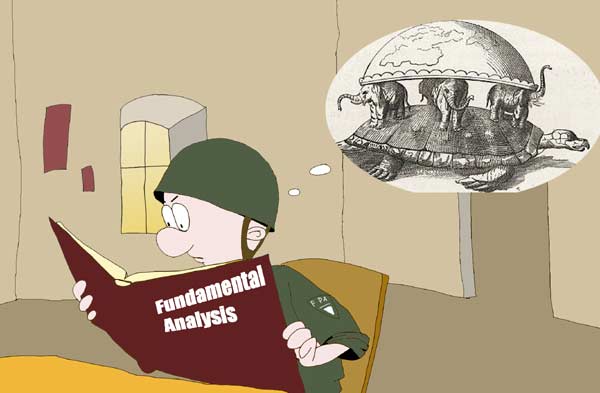Part I. Again about Fundamental Analysis

Pipruit: Does it mean that now you can tell me something new about it? I already know that fundamental analysis is the study of fundamentals. Will that be sufficient?

Different data that are used in fundamental analysis could make different impacts on currencies, as on any other asset. Here the task of fundamental analysis is to tell us how price should react under force of some fundamental factor, such as growth of interest rates. Fundamental data itself could take different shapes. As macro data it could be in shape of some statistical numbers that are released on a predetermined schedule – GDP, Unemployment, housing market, production, sales, budget deficit etc. It could be regular central bank testimony and interest rate decisions, changes in fiscal policy, some reports of government authorities on employment, retail sales etc.
Since information flow now happens very fast, anticipation of some event or data starts to move markets even before this event has happened or the data has been released. For those who know how to use this – the time before release is very happy one, since price could show solid moves, sometimes 100 pips or even more. That’s why there is so much expectations and rush around news time release – it’s big money time.
Macro data and other components of fundamental analysis create major part of the information that is used in analysis. For those who can read them, they could tell how healthy an economy is and how strong its perspectives are. So, reality of the current financial world tells us that anticipation of some fundamental event or data is as important as this data or event itself or even more. But this is just the first task. Since each data is just a part of the puzzle, the trader who uses fundamental analysis has to be able to understand how this particular part could change the overall picture.
Pipruit: Sir, it sounds awful…
Pipruit: Yeah, I know that you tell me every time – this is not as difficult as it sounds.
Commander in Pips: Ok, I have to agree with you, that fundamental analysis is more suitable to determining the overall future conditions of an economy, but not to predict tomorrow’s price action, or even for next month. It has some big gaps due the way information is provided – data releases and central banks announcements are not a MACD indicator, so this information is rather blurry. It gives such conclusions as “EUR could move higher if ECB will show continuation in rate increasing”, or “gradual unemployment decrease will lead to USD strength”.
Still, there is such kind of analysis that is called “regression”. This is some equation that combines different fundamental factors. For instance, interest rates, GDP, unemployment and budget deficit – the number of parameters could be different. When you paste all that numbers into an equation, it could give you, for instance, a fair EUR/USD rate. If the fair rate is higher than current one – you make a decision to purchase EUR/USD, if lower – to sell EUR/USD. These kind of regression equations are usually create by statisticians and this is tough work to do. Still, this is a real and sharp application of fundamental analysis.
By the way, if want to be up to date with the current macro data picture, visit the FPA's Current Forex Daily Trading Signals folder every day:
Current Forex Trading Signals
Also I have to say, that while some macro data is important itself, no less important (or even more important) is the market’s expectation or, say, prediction of that number. To make a judgment about how the actual number compares to forecasted number and how difference between them could influence market price action. All these things demand analysis before pulling the trigger.
Pipruit: Ok, let’s assume that some report just has been released…
Commander in Pips: Right. The market will behave depending on how traders assess the results of this release. According to what we’ve said above – how the actual figure corresponds with expectations, what actual figure stands itself, how it influence on the overall fundamental picture of a particular country that the currency belongs to. The first two points usually impact market fast, but the last one shows its influence during an extended period of time, sometimes right until the next release.
Pipruit: Oh, now I see. But Sir, in the time of release there are so many different opinions… Could it lead to a lot of uncertainty, even when we will see some particular number?
Understand that there are a lot of numbers, events appear on market day-by-day and many of them are significant. Traders and analytics need time to integrate them into the whole picture. And that is just data for some particular currency. But there is data for the other currency in a pair and for all other currencies as well. Traders have to combine them to make an acceptable assessment of economic perspectives and, hence some currency pair perspectives.
Pipruit: Although you’ve promised me that this will be simpler – it doesn’t sound simpler. May be I should not use fundamental analysis at all?
Commander in Pips: Well, we’ve discussed that already. There are a lot of followers on both sides. The major difference is while technical analysis focuses on price action, fundamental analysis focuses on currency valuation. So, short-term traders mostly deal with former, while intermediate and long-term traders, investors with the latter. The better way is to use both of them.
Commander in Pips: During important macro data releases, technical strategies very often fail during the market swings that can suddenly happen as large fundamental-based trades are opened and closed. From another point of view, pure fundamental traders miss a lot of short-term opportunities that technical tools could give to them.
So if you apply both of them – you will be armed for both cases – aware of scheduled fundamental data releases and what to do with them (remember Stavro’s page again) and applying technical tools to extract profit from short-term price action.
I know that probably you will not like it, but we will still discuss in this part of our School the basic macroeconomic factors that strongly affect currencies – economic reports, interest rates and central bank fiscal policy.
Commander in Pips: Well, we’ve discussed that already. There are a lot of followers on both sides. The major difference is while technical analysis focuses on price action, fundamental analysis focuses on currency valuation. So, short-term traders mostly deal with former, while intermediate and long-term traders, investors with the latter. The better way is to use both of them.
Pipruit: What for?
So if you apply both of them – you will be armed for both cases – aware of scheduled fundamental data releases and what to do with them (remember Stavro’s page again) and applying technical tools to extract profit from short-term price action.
I know that probably you will not like it, but we will still discuss in this part of our School the basic macroeconomic factors that strongly affect currencies – economic reports, interest rates and central bank fiscal policy.
Pipruit: Aaarrrgghhh…
Comments
F
fran alvarez
12 years ago,
Registered user
> Chapter 21, Part I. Again about Fundamental Analysis
Commander in Pips: Where's the preview for this chapter?
Pipruit: I heard that the FPA's AsstModerator was slacking and didn't ..
Heyyy.... Don´t do that Commander in Pips !!!!..., well.... not before the end of the course...
Commander in Pips: Where's the preview for this chapter?
Pipruit: I heard that the FPA's AsstModerator was slacking and didn't ..
Heyyy.... Don´t do that Commander in Pips !!!!..., well.... not before the end of the course...
Table of Contents
- Introduction
- FOREX - What is it ?
- Why FOREX?
- The structure of the FOREX market
- Trading sessions
- Where does the money come from in FOREX?
- Different types of market analysis
- Chart types
- Support and Resistance
-
Candlesticks – what are they?
- Part I. Candlesticks – what are they?
- Part II. How to interpret different candlesticks?
- Part III. Simple but fundamental and important patterns
- Part IV. Single Candlestick Patterns
- Part V. Double Deuce – dual candlestick patterns
- Part VI. Triple candlestick patterns
- Part VII - Summary: Japanese Candlesticks and Patterns Sheet
-
Mysterious Fibonacci
- Part I. Mysterious Fibonacci
- Part II. Fibonacci Retracement
- Part III. Advanced talks on Fibonacci Retracement
- Part IV. Sometimes Mr. Fibonacci could fail...really
- Part V. Combination of Fibonacci levels with other lines
- Part VI. Combination of Fibonacci levels with candle patterns
- Part VII. Fibonacci Extensions
- Part VIII. Advanced view on Fibonacci Extensions
- Part IX. Using Fibonacci for placing orders
- Part X. Fibonacci Summary
-
Introduction to Moving Averages
- Part I. Introduction to Moving Averages
- Part II. Simple Moving Average
- Part III. Exponential Moving Average
- Part IV. Which one is better – EMA or SMA?
- Part V. Using Moving Averages. Displaced MA
- Part VI. Trading moving averages crossover
- Part VII. Dynamic support and resistance
- Part VIII. Summary of Moving Averages
-
Bollinger Bands
- Part I. Bollinger Bands
- Part II. Moving Average Convergence Divergence - MACD
- Part III. Parabolic SAR - Stop And Reversal
- Part IV. Stochastic
- Part V. Relative Strength Index
- Part VI. Detrended Oscillator and Momentum Indicator
- Part VII. Average Directional Move Index – ADX
- Part VIII. Indicators: Tightening All Together
- Leading and Lagging Indicators
- Basic chart patterns
- Pivot points – description and calculation
- Elliot Wave Theory
- Intro to Harmonic Patterns
- Divergence Intro
- Harmonic Approach to Recognizing a Trend Day
- Intro to Breakouts and Fakeouts
- Again about Fundamental Analysis
- Cross Pair – What the Beast is That?
- Multiple Time Frame Intro
- Market Sentiment and COT report
- Dealing with the News
- Let's Start with Carry
- Let’s Meet with Dollar Index
- Intermarket Analysis - Commodities
- Trading Plan Framework – Common Thoughts
- A Bit More About Personality
- Mechanical Trading System Intro
- Tracking Your Performance
- Risk Management Framework
- A Bit More About Leverage
- Why Do We Need Stop-Loss Orders?
- Scaling of Position
- Intramarket Correlations
- Some Talk About Brokers
- Forex Scam - Money Managers
- Graduation!